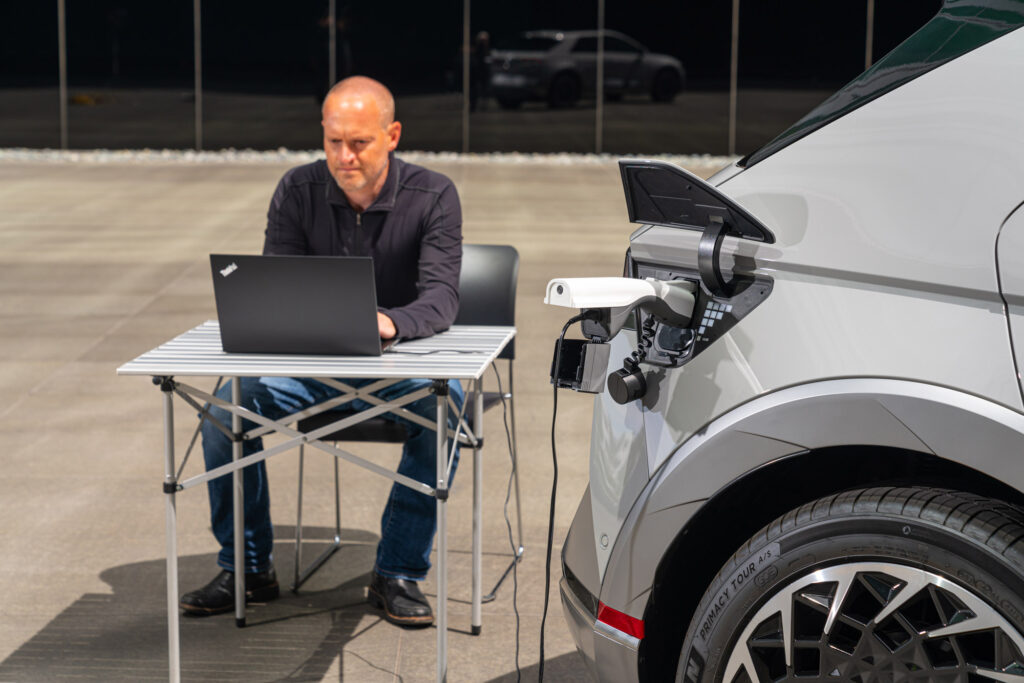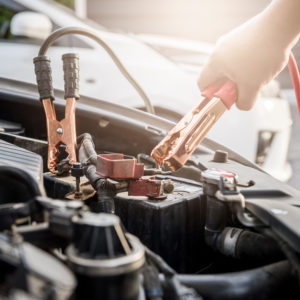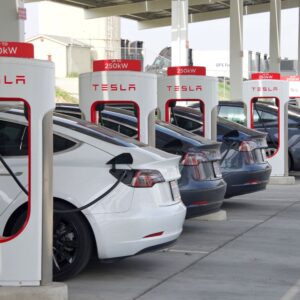Electric vehicles have come a long way since they were first introduced in the automotive market.
Aside from the environmental benefits (other than the horrible mining of lithium and cobalt) that come with driving one, electric vehicles have also paved the way for manufacturers to innovate charging practices that can be advantageous for applications outside a four-wheeled machine.
Bidirectional charging is a huge step forward for EV automakers, and this article will walk you through the imaginative process of the V2X project.
What Is Bidirectional Charging?
Bidirectional charging is a two-way process that lets EV chargers flow energy into and out of a vehicle.
During the charging process, a bidirectional charger converts AC power to DC, which is similar to how an inverter operates. During the discharging process, the charger will do the opposite, converting DC to AC.
Bidirectional chargers, however, are not compatible with all EVs. Only those that are capable of two-way DC charging can fully enjoy the benefits of bidirectional charging.
Opening the V2X Umbrella
Vehicle-to-everything (V2X) charging is a concept that addresses the ability of an electric vehicle to charge absolutely anything.
Unfortunately, there’s no EV that can supply power to any application as of this writing. There are, however, some EVs that are capable of conducting specialized charging processes, including V2H, V2L, V2V, and V2G.
V2H
Vehicle-to-house or V2H bidirectional charging uses the power from an EV to supply electricity to an entire home.
Similar to Tesla’s Powerwall, V2H bidirectional charger turns an EV into a backup power supply during an outage.
V2H charging also lets the user charge their EV during off-peak hours and use that power supply instead of the one from the grid during peak demand times.
A V2H charger requires an energy meter at the grid connection point to measure the grid electricity going into a home. The energy meter is responsible for communicating with the V2H charger to offset the same amount of electricity.
A V2H system that can detect a grid going offline can isolate itself from the grid and operate independently, acting like an off-grid inverter using the EV battery as the main power source.
Aside from an energy meter and a bidirectional home charger, a V2H setup requires a few more things.
Most setups will need smart energy management software to control the charging process, as well as a communications link between the charger, EV, and the charging management platform.
Lastly, a connection between the bidirectional charger and the home’s entry panel must be set.
V2L

Vehicle-to-load or V2L is a charging setup that enables an EV with on-board 110-volt power plugs to supply power to any appliance. Most EVs have a power limit when it comes to this setup, which is usually up to 3.6 kW only.
In some cases, a special adapter needs to be plugged into the EV charging port to power appliances.
V2L technology is extremely beneficial for those who often go on camping trips. An EV battery can power appliances for days, including refrigerators, TVs, power tools, and more.
V2V
Vehicle-to-vehicle (V2V) charging is a form of V2L, given that a vehicle can be considered as somewhat of an appliance.
While this might be the case, not all vehicles capable of V2L charging can accommodate V2V charging.
The Lucid Air EV is an example of a vehicle that can conduct V2V charging. Using a special adapter, this model can draw power from its own battery to jump another EV.
It is, however, limited to supplying up to 9.6 kW, which is only about 30 miles of range per hour.
V2G
Vehicle-to-grid (V2G) technology operates at a larger scale than the other charging systems.
In a V2G system, the EV battery delivers energy to the power grid and only works that way. It’s not a bidirectional process and only involves discharging the EV battery.
Basically, you’ll be charging your EV only for the power to be relocated to the grid. A V2G system comes in handy when the grid is overloaded due to excessive power consumption.
By installing V2G charging stations in large buildings and other establishments, sourcing energy from power plants won’t be done as much and renewable energy can be stored.
For V2G technology to be successful, EV owners must be willing to hold up their end of the bargain.
The question is, why should EV owners charge up and discharge for the grid?
Well, a lot of companies are willing to pay for energy to be stored in their grids, so EV owners can make a profit out of giving away their EV battery’s stored energy.
V2H Compatible Cars
Only a handful of vehicles are capable of bidirectional charging. As of this writing, these models include:
- Nissan Leaf (2013 onwards)
- Ford F-150 Lightning
- Hyundai Ioniq 5
- Hyundai Ioniq 6
- Kia EV6
- Genesis GV60
Installation Costs for Bidirectional Charging
A V2H bidirectional charger is a long-term investment, especially if you consider the perks that come with installing one.
So if you’re planning to get one anytime soon, know that this charging system doesn’t come cheap.
For instance, Ford’s Charge Station Pro together with the Home Integration System can cost up to $18,000 to set up. This also includes upgrading the amp service.
GM Energy also offers a V2H setup. The EV charger alone can cost a little over $1,300 with an additional $2,500 for installation. Should you want to go for a full V2H setup, you can expect to throw in another $10,000.
The total cost of installing a V2H bidirectional charger will ultimately depend on the manufacturer.
And while the amount can seem lucrative, a V2H setup does have its perks, especially when there are power outages. It can also help you save on electricity consumption in the long run by avoiding the grid’s peak hours.
Lastly, with EVs gaining more popularity, you can expect more models to come with bidirectional charging options in the years to come.
Any information provided on this Website is for informational purposes only and is not intended to replace consultation with a professional mechanic. The accuracy and timeliness of the information may change from the time of publication.


























